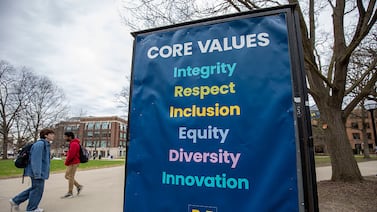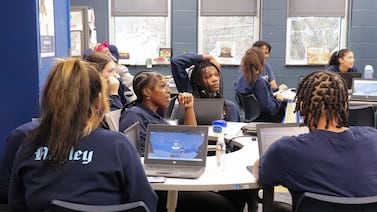As the majority of Denver Public Schools students learn from home amid rising rates of COVID, public health officials are reconsidering which metrics they should be tracking to determine when it’s safe for students and teachers to be in school.
Rather than looking primarily at how widespread COVID is in the community, they want to look at how prevalent COVID is in schools and how disruptive the management of the pandemic is to instruction. Dr. Bill Burman, director of Denver Public Health, said this week that he and his colleagues are “actively re-examining that question” based on local and national data and the experience of other districts.
“What we’ve recognized is that schools can be a safe place if they are following [safety protocols] even in situations of higher community transmission than anticipated,” he said. “Rather than having a dashboard that reflects metrics of community transmission, maybe it should be metrics of school safety and school disruption.”
Burman said he’s working closely with Dr. Steven Federico, the head of general pediatrics at Denver Health, to identify new metrics, which ideally would identify whether COVID is spreading within schools, rather than simply reflect that many people in the community have COVID. The goal is to have something in place before the next major decision point for the district.
Denver Public Schools has sent older elementary students home at least through the Thanksgiving holiday, with hopes of bringing them back if the public health situation improves. Middle and high school students will learn remotely until at least January. Students in kindergarten through second grade, as well as those in center-based programs for students with disabilities and newcomer programs for recent immigrants, still have the option to attend school in person.
At the same time, Burman said, the number of cases and hospitalizations needs to stabilize, rather than continue their alarming increase, before bringing students back to school.
“It’s hard to expand in-person school not just at a time when case rates are high but they’re going up,” he said.
Denver Public Schools’ COVID dashboard, launched in August, tracks how many cases per 100,000 have occurred in the community over the last two weeks, the rate of increase in cases, and test positivity. It’s similar to guidelines issued by national health experts over the summer and adopted by many other school districts.
Denver’s COVID dashboard turns to red, a serious warning sign, when there are more than 100 cases per 100,000 residents, when cases have increased more than 50% in a two-week period, and when test positivity rises above 7%. Some metrics have been red since September, and all three metrics have been red for more than a week, with Denver currently seeing more than 600 cases per 100,000 residents and test positivity at 10%.
Denver, along with more than a dozen other Colorado counties, is at risk of moving to the state’s highest level of restrictions, “Stay At Home,” if the trends don’t change soon. The Denver Post reported this week that Mayor Michael Hancock is considering a curfew, among other measures, in an effort to stave off that step.
Denver Public Schools’ dashboard doesn’t create any hard thresholds for when school must be remote, and state rules give school districts discretion about whether to remain open, even under Stay At Home.
Denver’s decision to send older elementary students home a week after bringing them back to the classroom sparked protests from some parents, with about 100 people in blue T-shirts that read #saferatschool gathering outside Denver Public Schools headquarters last Friday.
Tyler Carlson, a Park Hill parent who helped organize the protest, said he recognizes that it’s unlikely the district would bring older elementary students back to the classroom immediately after sending them home, but he’s hoping for a clear plan for what it would take to eventually do so.
COVID isn’t going anywhere, he said Friday, and children are better off in school.
The unions that represent principals and teachers, many of whom are worried about the safety of being in the classroom, have asked repeatedly for clearer thresholds for when the district would open school buildings and when in-person learning becomes unsafe.
District administrators have treated the dashboard as a “flashing red light” that prompts consultation with public health officials but there is no clear line for when there would be no in-person school. Even as parents have raised concerns about their children being out of school, some teachers who are still reporting to school buildings have said they don’t feel it’s safe.
The types of changes to the dashboard that Burman and Federico are considering would not address whether the district should have a hard threshold. At the same time, Burman said he is not proposing, for example, changing the thresholds of case rates or levels of test positivity that would trigger concern.
School districts around the Denver metro area are struggling with how to respond to rising case counts. Several districts in Adams County, to the north and east of Denver, have also moved some or all students to remote learning.
On Thursday, Cherry Creek Schools and the Sheridan district both announced they would move to remote learning as well until they see consistent improvement in COVID metrics. In consultation with Tri-County Public Health, Cherry Creek had developed a more complex dashboard that incorporates school-related metrics, which remained in less concerning ranges than the community metrics. However, Superintendent Scott Siegfried said in a letter to parents that the rate of transmission in the community had reached a point that students and staff were testing positive frequently enough it was very disruptive to school operations.
Burman said he and his colleagues are looking at school-specific metrics like those Cherry Creek incorporated, but they’re still not sure exactly what those will be.
“The idea isn’t to shift the goal posts,” Burman said. “That clearly raises concerns. It’s more, ‘were these the wrong goal posts?’”
Denver Superintendent Susana Cordova said she has heard clearly from parents who want in-person learning but also from many parents who have safety concerns.
For now, the best thing people can do to get students back in school, she said, is to follow public health orders to reduce COVID numbers.
“Our goal is to bring back as many students as soon as possible for in-person instruction,” she said.






